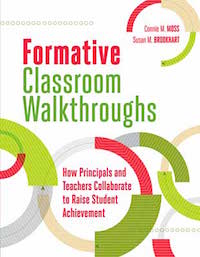Classroom Walkthroughs Can Build Culture
Formative Classroom Walkthroughs: How principals and teachers collaborate to raise student achievement
By Connie M. Moss and Susan M. Brookhart
(ASCD, 2015 – Learn more)

All too often in our schools, classroom walkthroughs are perceived by most in a negative way. Some administrators see them as “must do” checklist activities, and many teachers fear that they will turn into “gotcha” opportunities.
If this is the culture in your school, and you are looking to take action to change that culture, then Formative Classroom Walkthroughs is a must read for the entire staff of your building.

When thinking of culture, collaboration must be front and center. As you read this book, you will immediately get the sense that classroom walkthroughs are learning opportunities. These opportunities will lead to significant professional and student growth.
Through this collaboration of “shared risk,” a trust will grow and it is this trust that allows all stakeholders to take chances for the benefit of the students.
It Starts with Culture
Instantly you can tell that this book has nothing to do with teacher evaluations, but rather formative walkthroughs. Commonly these two practices are seen as one, but in reality they are completely different. Moss and Brookhart put all the focus on student learning and how the teachers and administrators must collaborate and become involved in meaningful, actionable discussions to allow everyone to grow.
To implement the processes in this book, Moss and Brookhart take some time and discuss what a culture of learning is and identify six behaviors that are critical to the development of this culture. When put into action, these behaviors will create a system of support and are intended to be non-threatening.
3 Central Questions to Improve Student Performance
In order to improve on classroom instruction, teachers need to ask themselves three important questions:
► Where am I headed?
► Where am I now?
► What closes the gap?
Moss and Brookhart use these three questions as the guiding force of their walkthrough process. Each chapter is dedicated to providing specific examples and look-fors that help determine the best answers to the questions.
Brookhart and Moss walk you as the reader through each of their chapters as if they are collaborating with you. Each chapter is dedicated to a specific look-for when conducting a walkthrough. That list includes:
► Looking for a worthwhile lesson
► Looking for a learning target
► Looking for a performance of understanding
► Looking for student look-fors
► Looking for formative feedback
► Looking for student self-assessment
► Looking for effective questioning
Don’t think you are going to find a checklist in this book. These look-fors are directed specifically at student performance. Upon completion of each chapter, you will have a deep understanding of what you are looking for, how to communicate it to the teacher, and then how to create a plan of action. It is these steps that make this book such a valuable resource to all.
The Authors Provide the Detail We Need
Reading Formative Classroom Walkthroughs is like having Susan Brookhart and Connie Moss sitting next to you, coaching you through the process. The chapters are extremely detailed and are set up consistently to ensure the reader understands exactly what the look-for is and how to implement it. Each chapter has the same sections but is changed for what the reader is specifically learning to look for.
The example I chose is chapter 4 and it focuses on looking for a worthwhile lesson. The first question is: What is a worthwhile lesson? The beauty of this book is the details, explanations, and examples that the authors use to ensure the reader truly understands and can apply the information in the book. Once the reader understands what they are looking for, the next part of the chapter is: How do effective teachers design a worthwhile lesson?
It is easy to see the flow and how it lends itself to collaboration. Moss and Brookhart do not want you to tell a teacher they need to do better, they want to you to work with them on how everyone (including the administrator) will get better.
By showing us how great teachers design their lessons, the chapter provides the collaborators with the tools to help design and implement effective lessons for student learning. This is a collaborative process, and in this process of walkthroughs, the administrators (or peer or coach) need to grow as well.
This leads to the third part of each chapter: How will I recognize a worthwhile lesson? In my opinion, this is the most critical aspect of the book. If the observer cannot determine if a lesson is worthwhile, then the process of collaborative improvement immediately ends right there.
Now that the chapter’s important background information has been discussed, Moss and Brookhart give specific examples of how the look-fors might appear in different classes, with different students learning different subjects. The authors take it a step forward by also providing the reader with strategies to provide evidence that students are engaged in the learning we are looking for.
A Practitioner’s Guide to Success
While research-based, Formative Classroom Walkthroughs reads as a guide or manual for success and not a research paper. Moss and Brookhart provide examples, scenarios, and checks for understanding to ensure that the reader has a complete grasp of this ever so important topic.
If you are a teacher looking to improve your craft to provide more meaningful opportunities for students, then this is your book. If you are an administrator who wants to become a more effective instructional leader, then this is your book.
Most importantly, if you are a team of educators who want to collaboratively work together to have a great impact on all the students in your building and build a culture of collaboration, Formative Classroom Walkthroughs will be the guiding force to make that change.
Mike Janatovich is an Assistant Principal for Harmon Middle School in Aurora, Ohio. Prior to becoming a middle level administrator, Mike spent 10 years serving middle level students as a 7th and 8th grade science and social studies teacher. As a middle level advocate, Mike believes that educating the whole child is critical in ensuring academic success. Recently Mike was selected to be a part of the ASCD 2015 Class of Emerging Leaders.



































